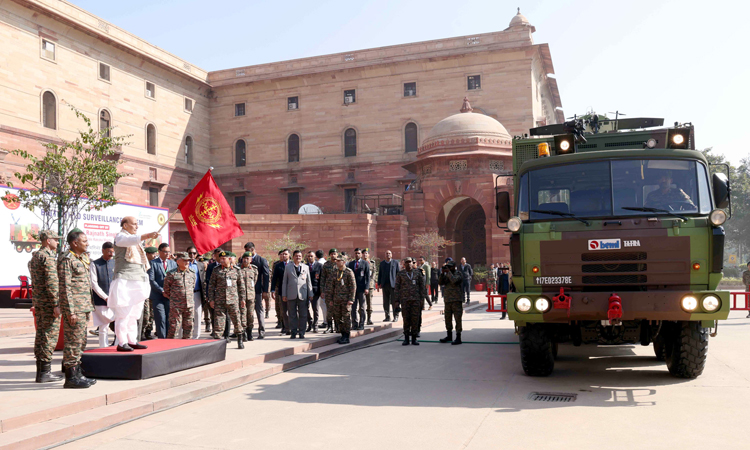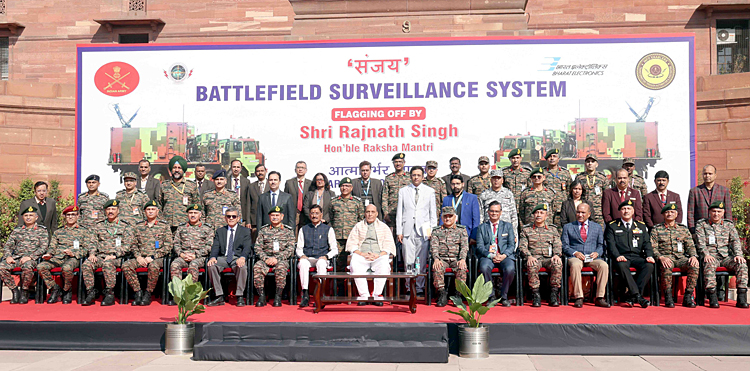INDIAN ARMED FORCES CHIEFS ON OUR RELENTLESS AND FOCUSED PUBLISHING EFFORTS

The insightful articles, inspiring narrations and analytical perspectives presented by the Editorial Team, establish an alluring connect with the reader. My compliments and best wishes to SP Guide Publications.

"Over the past 60 years, the growth of SP Guide Publications has mirrored the rising stature of Indian Navy. Its well-researched and informative magazines on Defence and Aerospace sector have served to shape an educated opinion of our military personnel, policy makers and the public alike. I wish SP's Publication team continued success, fair winds and following seas in all future endeavour!"

Since, its inception in 1964, SP Guide Publications has consistently demonstrated commitment to high-quality journalism in the aerospace and defence sectors, earning a well-deserved reputation as Asia's largest media house in this domain. I wish SP Guide Publications continued success in its pursuit of excellence.
- MoD initiates comprehensive review of Defence Acquisition Procedure 2020, pushes for defence reforms
- G7: The Swansong
- Kalinga Connect: South Asia to Polynesia
- Must Credit DRDO for Operation Sindoor, now what is next for defence R&D?
- The layered Air Defence systems that worked superbly, the key element of Operation Sindoor
- Operation Sindoor | Day 2 DGMOs Briefing
- Operation Sindoor: Resolute yet Restrained
SANJAY Battlefield Surveillance System
SANJAY is an automated system that integrates the inputs from all ground and aerial battlefield sensors and fusing them to produce a Common Surveillance Picture of the battlefield
 |
The Author is Former Director General of Information Systems and A Special Forces Veteran, Indian Army |

On January 24, 2025, Defence Minister Rajnath Singh flagged off the 'SANJAY' Battlefield Surveillance System (BSS) from South Block, New Delhi. MoS Defence Sanjay Seth, Chief of Defence Staff General Anil Chauhan, Chief of the Army Staff General Upendra Dwivedi, Defence Secretary Rajesh Kumar Singh and other senior officials of MoD and BEL were present during the flagging-off ceremony. SANJAY is an automated system that integrates the inputs from all ground and aerial battlefield sensors, processing them to confirm their veracity, preventing duplication and fusing them to produce a Common Surveillance Picture of the battlefield over a secured Army Data Network and Satellite Communication Network. SANJAY will enhance battlefield transparency and transform the future battlefield through a Centralised Web Application which will provide inputs to Command and Army Headquarters, and the Indian Army Decision Support System (DSS).
SANJAY will enhance battlefield transparency and transform the future battlefield through a Centralised Web Application which will provide inputs to Command and Army Headquarters, and the Indian Army Decision Support System (DSS)
SANJAY is equipped with state-of-the-art sensors and cutting-edge analytics. It will monitor the vast land borders, prevent intrusions, assess situations with unparalleled accuracy and prove to be a force multiplier in Intelligence, Surveillance & Reconnaissance. This would enable commanders to operate in both conventional & sub-conventional operations in a Network Centric Environment. Its induction will be an extraordinary leap towards data and network centricity in the Indian Army. The system has been indigenously and jointly developed by the Indian Army and Bharat Electronics Limited (BEL), flagged off in the Indian Army's 'Year of Technology Absorption'. SANJAY is to be inducted in all operational Brigades, Divisions and Corps of the Indian Army in three phases from March to October of 2025, which has been declared as 'Year of Reforms' in the Ministry of Defence (MoD). This system has been developed under the Buy (Indian) category at a cost of ₹2,402 crore, as per a release by the MoD.

The relationship between information and combat is well known. However, the challenge has always been as to how it can be maximised. All military operations are conducted in three domains. Two of these – the physical domain and the domain of the mind are well known and understood. The physical domain is where attack, defence and manoeuvre occur – on ground, sea, air or space. Elements of this domain are easy to measure, like lethality and survivability. The domain of the mind is where battles are won and lost. This is the domain of the intangibles: leadership, morale, unit cohesion, level of training and experience, public opinion and so on. Key attributes of these intangibles have remained relatively constant.
The system has been indigenously and jointly developed by the Indian Army and Bharat Electronics Limited (BEL)
The third domain is that of information. It is this domain which is now increasing combat power in a broad range of operations. It is Network Centric Warfare (NCW) capable forces that help us to share a common operational picture, resulting in a very high level of shared situational awareness. In its effort for capacity building in NCW, the Army has been working to develop its Tactical Command, Control, Communications and Information (Tac C3I) System. Within the Tac C3I, the subsystems of Command Information Decision Support System (CIDSS), Battlefield Support System (BSS), Artillery Command Control and Communications System (ACCCS), Air Defence Control and Reporting System (ADC&RS) and Battlefield Management System (BMS) are all bound by the CIDSS as the backbone, also configured to integrate systems like the Army's Electronic Warfare System (EWS) and Electronic Intelligence System (ELINT) operating under Military Operations and Military Intelligence, respectively.
Project SANJAY was conceived to develop an automated system with dedicated intra-communication, which involves integration of surveillance sensors of operational formations on a customised GIS platform with multi-sensor data fusion undertaken at the Surveillance Centre for providing inputs to the CIDSS. The system was developed on turnkey basis by BEL in collaboration with the Centre for Artificial Intelligence & Robotics (CAIR) under the Defence Research and Development Organization (DRDO). The complete fielding of BSS in the Army, to integrate Indian Army's total surveillance resources, was to be completed in 2017. But bureaucratic red tape apart, BEL continued to face the same problems it had been facing in developing the ACCCS; which included bulk imported hardware and technology but limited indigenous capacity in applications, design and software customisation.
Project SANJAY was conceived to develop an automated system with dedicated intra-communication, which involves integration of surveillance sensors of operational formations on a customised GIS platform with multi-sensor data fusion undertaken at the Surveillance Centre for providing inputs to the CIDSS
Ignoring the fact that SANJAY, developed at a cost of ₹2,402 crore, is getting fielded into the Indian Army more than seven years after its fielding was to be completed in 2017, would be naïve. It should set us thinking the following: first, with this pace of research and development, how do we expect to catch up with the rapid advances made and being made by China: second, isn't it about time we acknowledge that the private sector would have handled the project more efficiently and without delay in fielding the system. The argument that such systems should only be developed by the DRDO for reasons of 'security' should also be viewed in context of CAIR admitting it does not develop any capacity for developing applications and must 'outsource' their development.





